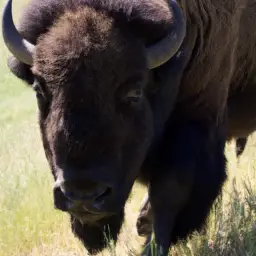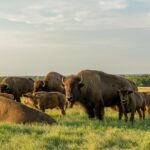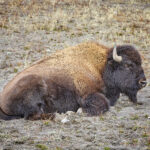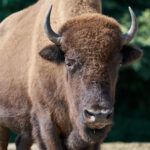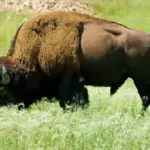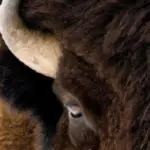Imagine a world where you can explore the fascinating history and current population of bison in the United States with just the tap of a finger. Introducing “How Many Bison In Us” – an innovative and user-friendly app that provides a captivating glimpse into the wild herds that once roamed the American plains and the efforts being made to conserve and protect them today. With stunning visuals, interactive maps, and engaging content, this app is your personal gateway to understanding the important role bison play in our nation’s heritage and future. Get ready to embark on a virtual journey like no other!
Historical Overview of Bison Population in the US
Bison population decline in the 19th century
In the 19th century, the bison population in the United States experienced a significant decline due to various factors. The arrival of European settlers and westward expansion brought about habitat loss, as grasslands were converted into farmland. Additionally, the demand for bison hides for trade purposes led to massive hunting and decimation of the bison population. The introduction of firearms made it easier for hunters to kill bison in large numbers, almost pushing them to the brink of extinction.
Efforts to resuscitate the bison population
Realizing the ecological and cultural importance of bison, conservation efforts were initiated to prevent their complete extinction. In the late 19th and early 20th centuries, individuals and organizations began working to protect and restore the bison population. Organizations, such as the American Bison Society and the Wildlife Conservation Society, played a crucial role in these efforts.
Bison population growth in the 20th and 21st centuries
Thanks to the conservation efforts made in the 20th century, the bison population started to gradually recover. The establishment of protected areas, such as national parks and wildlife refuges, provided suitable habitats for bison populations to thrive. Additionally, the implementation of hunting regulations and the ban on the commercial hunting of bison helped stabilize their numbers. As a result, the bison population has seen substantial growth in the 20th and 21st centuries.
Current Numbers of Bison in the US
Estimates of wild and semi-wild Bison
As of the most recent estimates, there are approximately 31,000 wild and semi-wild bison in the United States. These bison are primarily found in protected areas like national parks, wildlife refuges, and Native American lands. It is important to note that the term “semi-wild” refers to bison residing in conservation herds that are considered genetically pure but live in semi-natural conditions, such as large fenced enclosures.
Estimates of Bison population in captivity
In captivity, the bison population is significantly higher, with approximately 500,000 bison being raised on ranches across the United States. These captive herds serve multiple purposes, including meat production, conservation breeding programs, and tourism. Bison farming has gained popularity due to the increasing demand for lean and sustainable meat, as well as the economic opportunities it provides to ranchers.
Projection of future Bison population trends
Experts predict that the bison population will continue to grow steadily in the coming years, both in the wild and in captivity. The expansion of protected areas and ongoing conservation efforts are expected to contribute to the increase in wild bison populations. Additionally, the market demand for bison meat and the profitability of bison farming create incentives for ranchers to continue increasing their captive herds.
Bison Population Per State
Bison population in the western states
The western states of the United States, such as Montana, Wyoming, and Colorado, are home to the largest populations of bison. Montana, in particular, is known for its vast grasslands and numerous national parks that provide ideal habitats for bison. These states have implemented successful conservation programs and collaboration with Native American tribes to maintain and increase the bison populations.
Bison population in the mid-western states
The mid-western states, including South Dakota and Nebraska, also have substantial bison populations. South Dakota, in particular, is often referred to as the “Bison State” due to its significant number of bison herds. Conservation efforts in these states have led to the restoration and expansion of bison populations, boosting local economies through ecotourism and bison-related industries.
Bison population in the eastern states
While the eastern states historically lost their native bison populations, efforts are being made to reintroduce bison into suitable habitats in these regions. States like New York, Illinois, and Ohio have established bison herds in state parks and preserves, aiming to restore ecological balance and provide opportunities for education and cultural enrichment.
Impact of Bison Conservation Programs
Conservation programs responsible for increased numbers
Conservation programs focusing on bison have played a pivotal role in the recovery of their populations. Efforts by federal agencies, such as the U.S. Fish and Wildlife Service and the National Park Service, have involved habitat restoration, captive breeding, and reintroduction initiatives. Public-private partnerships and collaborations with Native American tribes have also been instrumental in conserving and restoring bison populations.
Controversies and debates surrounding conservation programs
Like many conservation efforts, bison conservation programs have faced controversies and debates. Some disagreements arise from differing perspectives on land use, wildlife management, and the involvement of Native American tribes. Debates surrounding the hunting of bison, contraceptive methods used in captive herds, and the potential impact of bison on private land are ongoing topics of discussion within the conservation community.
Success stories of Bison conservation
Despite the controversies, bison conservation programs have achieved notable successes. The recovery of the bison population in Yellowstone National Park, where bison were once on the brink of extinction, is considered a significant conservation triumph. The establishment of various conservation herds across the United States, which serve as genetic reservoirs, has also been crucial in preserving the genetic diversity of bison populations.
Role and Importance of Bison in Ecosystems
The ecological role of Bison in grassland ecosystems
Bison play a vital ecological role in grassland ecosystems. Their grazing behaviors help maintain the health and diversity of grasslands by preventing the dominance of certain plant species. Bison graze selectively, creating a varied mosaic of vegetation heights and densities, which benefits a wide range of plant and animal species that depend on these habitats.
Contribution of Bison to biodiversity
Bison also contribute to biodiversity by creating and maintaining habitats for numerous plant and animal species. Their wallowing activities, such as rolling in the dirt, create small depressions that collect water and provide breeding sites for amphibians and insects. These seeps and wallows attract a variety of birds, mammals, and reptiles, enhancing the overall biodiversity of grassland ecosystems.
Effects of Bison on soil and vegetation
The presence of bison has significant effects on soil and vegetation. Their grazing and trampling behaviors help cultivate the soil and enhance nutrient cycling. By removing old grasses and compacting the soil, bison facilitate the growth of new plant shoots and create favorable conditions for seed germination. Their dung also acts as a natural fertilizer, enriching the soil with essential nutrients.
The Importance of Bison to Indigenous Cultures
Bison in Indigenous symbolism and spirituality
Bison hold profound spiritual and cultural significance for many Indigenous communities in the United States. They are often considered sacred animals and are integrated into various aspects of Indigenous cultures. The bison’s strength, resilience, and ability to provide for Indigenous peoples have made it an important symbol of survival, spirituality, and communal well-being.
Historical importance of Bison in Indigenous economies
Bison were historically crucial to Indigenous economies, providing various resources for survival. Indigenous communities relied on the bison for meat, fur, clothing, blankets, tools, and even shelter. The communal hunting of bison was a central part of Indigenous societies, fostering cooperation, social cohesion, and the sharing of resources among community members.
Modern day significance of Bison to Indigenous cultures
In modern times, the revival of bison populations holds profound cultural and economic significance for Indigenous communities. Increased bison populations provide opportunities for cultural revitalization, as well as sustainable hunting and subsistence practices. Bison-related ecotourism, tribal bison enterprises, and bison-based cultural initiatives have created economic benefits and strengthened the connection between Indigenous communities and their ancestral lands.
Roles of Bison in Modern Agriculture
Raising Bison for meat production
Bison farming has gained recognition as a sustainable and ethical alternative to conventional livestock farming practices. Bison meat is known for its nutritional value, being low in fat and cholesterol while high in protein and essential nutrients. As consumer demand for healthy and sustainable meat options increases, bison farming offers a viable solution for ranchers and consumers alike.
Environmental benefits compared to other livestock
Compared to other livestock, bison farming provides several environmental benefits. Bison are well-adapted to grassland ecosystems and require minimal supplemental feeding, reducing the need for intensive agricultural practices. Their grazing behaviors can also contribute to improved soil health, carbon sequestration, and the maintenance of grassland habitats for other species.
Economic significance of Bison farming
Bison farming offers economic opportunities for ranchers and rural communities. The direct sale of bison meat, hides, and other byproducts can generate revenue and support local economies. Furthermore, bison-related tourism, such as guided tours and educational programs, provides additional income streams for ranchers and helps promote the conservation of bison and their ecosystems.
Threats to Bison Populations in the US
Effects of climate change on Bison
Climate change poses significant threats to bison populations in the United States. Rising temperatures, altered precipitation patterns, and more frequent extreme weather events can impact the availability and quality of forage, water sources, and suitable habitat for bison. These changes put additional stress on bison populations, affecting their reproductive success and overall survival.
Disease threats to Bison population
Bison populations are susceptible to various diseases, including brucellosis and chronic wasting disease. Brucellosis, a bacterial infection, can cause reproductive issues, leading to lower calf survival rates and population growth. Chronic wasting disease, a prion disease, impacts the nervous system and can have devastating effects on bison populations. Effective disease management and surveillance programs are essential to protect bison populations from these threats.
Effects of hunting and poaching
Despite protective measures, illegal hunting and poaching remain ongoing threats to bison populations. Poaching for their meat, hides, and other body parts can have significant impacts on both wild and captive bison populations. Strict enforcement of hunting regulations and public awareness campaigns are crucial in reducing these illegal activities and ensuring the long-term survival of bison.
Legal Protection and Legislation for Bison
Bison as a national mammal and associated protections
In 2016, bison were designated as the national mammal of the United States, highlighting their cultural, historical, and ecological significance. This designation symbolizes the importance of bison conservation and the need to preserve their habitats. Various federal acts, such as the Endangered Species Act and the National Wildlife Refuge System Improvement Act, provide legal protection and conservation measures for bison populations.
State laws regulating Bison
Individual states also have laws and regulations in place to protect and manage bison populations. These regulations may cover issues such as hunting seasons, herd management, disease control, and captive bison farming. State departments of fish and wildlife, as well as agricultural agencies, work closely with federal entities to ensure the effective implementation of these laws and regulations.
Controversies and debates surrounding Bison legislation
Like any legislation involving wildlife management, bison-related laws can be a subject of controversy and debate. Disagreements may arise regarding hunting quotas, the impact of bison on private land, or conflicts between bison and domestic livestock. Balancing the needs of conservation, private landowners, and agricultural interests requires ongoing dialogue and collaboration among stakeholders.
Is the Bison Population in the US a Significant Portion of the Global Bison Population?
The number of bison worldwide is a small portion of what it used to be, with the majority of bison living in North America. The US bison population makes up a significant portion of the global bison population, with conservation efforts focused on increasing their numbers and preserving their habitat.
The Future of Bison in the US
Predicted trends and developments
Experts predict that the bison population in the United States will continue to increase, both in the wild and in captivity. As conservation efforts expand, more suitable habitats will be established, allowing for the reintroduction and recovery of bison populations in various regions. Additionally, advancements in genetic research and technology may further enhance breeding and conservation programs, ensuring the long-term survival of bison.
Proposed conservation and management strategies
To secure the future of bison populations, several conservation and management strategies have been proposed. These include the expansion of protected areas, the establishment of additional conservation herds, and the promotion of genetic diversity through population management. Collaboration between federal agencies, Native American tribes, and private landowners will be crucial in implementing these strategies effectively.
Impact of changing climate on future Bison populations
The changing climate presents significant challenges for the future of bison populations. Conserving and restoring suitable habitats, ensuring access to adequate forage and water sources, and effectively managing disease risks will become increasingly important. Adaptive management approaches, ongoing research, and the integration of traditional ecological knowledge will help address the impacts of climate change on bison populations.
In conclusion, the historical decline and subsequent recovery of the bison population in the United States serve as a testament to the importance of conservation efforts. Bison play a crucial role in ecosystems, contribute to biodiversity, and hold deep cultural significance for Indigenous communities. The future of bison in the United States depends on continued conservation efforts, collaboration among stakeholders, and adaptive management strategies in the face of changing climatic conditions. By protecting and preserving these iconic animals, we not only ensure their survival but also help maintain the ecological integrity and cultural heritage of the United States.

